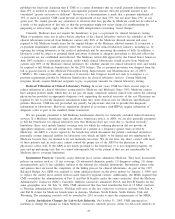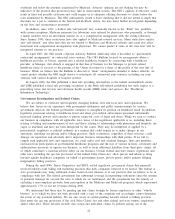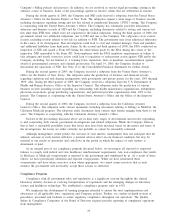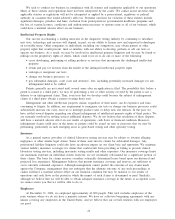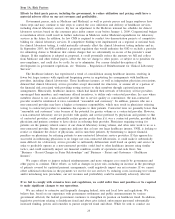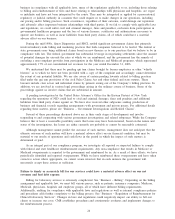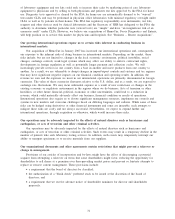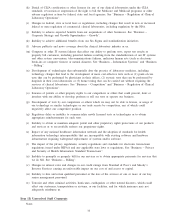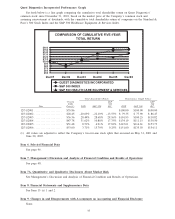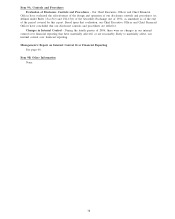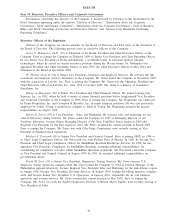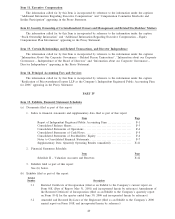Quest Diagnostics 2006 Annual Report Download - page 51
Download and view the complete annual report
Please find page 51 of the 2006 Quest Diagnostics annual report below. You can navigate through the pages in the report by either clicking on the pages listed below, or by using the keyword search tool below to find specific information within the annual report.physicians have obtained NPIs. There is industry concern with the number of physicians and other health
providers who have not yet obtained NPIs, and various groups have requested that CMS consider adopting a
contingency period of one year or more for compliance with NPI regulations. While CMS has adopted similar
contingency periods for electronic claim and remittance transactions in the past, there is no indication yet that
they will do the same for NPI. We will continue efforts to obtain available referring physician NPIs, and expect
that most of the available NPIs will be obtained prior to May 23, 2007. We could face a disruption in
reimbursement with respect to tests referred by clients that do not timely receive NPIs.
Compliance with all of the HIPAA regulations, including the regulations for electronic transactions and NPIs,
requires ongoing resources from all healthcare organizations, not just Quest Diagnostics. While we believe our
total costs to comply with HIPAA will not be material to our operations or cash flows, new standard transactions
and additional customer requirements resulting from different interpretations of the current regulations could
impose additional costs on us.
FDA regulation of laboratory-developed tests, analyte specific reagents, or genetic testing could lead to
increased costs and delays in introducing new genetic tests.
The FDA has regulatory responsibility over instruments, test kits, reagents and other devices used to perform
diagnostic testing by clinical laboratories. In the past, the FDA also claimed regulatory authority over laboratory-
developed tests, but has stated that it is exercising enforcement discretion in not regulating most laboratory-
developed tests performed by high complexity CLIA-certified laboratories. On September 7, 2006, the FDA
published two draft guidance documents. The first draft guidance document describes various manufacturer
practices and products that the FDA believes would take certain reagent products out of the Class I (exempt)
Analyte Specific Reagent (ASR) category. The ASR draft guidance, if adopted as proposed, could restrict
laboratory access to certain products now available, if in response to its adoption, manufacturers voluntarily
withdraw their products from the market. The other draft guidance document describes certain laboratory-
developed tests that the FDA intends to regulate as in vitro diagnostic test systems (i.e., as medical devices). The
FDA calls this category of laboratory-developed tests “In Vitro Diagnostic Multivariate Index Assays”
(IVDMIAs). The IVDMIA draft guidance, if adopted as published, would extend FDA oversight over laboratories
that offer certain laboratory-developed tests. Many of the esoteric tests that we develop internally are first offered
as laboratory-developed tests. FDA regulation of laboratory-developed tests or increased regulation of the various
medical devices used in laboratory-developed testing would lead to increased regulatory burden and additional
costs and delays in introducing new tests, including genetic tests. The FDA has extended to March 5, 2007 its
original deadline for public response to the draft guidance documents.
Failure to develop, or acquire, licenses for new or improved testing technologies, or the development of
new, more cost-effective tests that can be performed by our customers or by patients, could negatively
impact our testing volume and net revenues.
The diagnostics testing industry is faced with changing technology and new product introductions. Other
companies or individuals, including our competitors, may obtain patents or other property rights that would
prevent, limit or interfere with our ability to develop, perform or sell our tests or operate our business. Our
success in remaining a leading innovator in the diagnostic testing industry by continuing to introduce new tests,
technology and services will depend, in part, on our ability to license new and improved technologies on
favorable terms. We may be unable to continue to negotiate acceptable licensing arrangements and such
arrangements will yield commercially successful diagnostic tests. If we are unable to license these testing
methods at competitive rates, our research and development costs may increase as a result. In addition, if we are
unable to license new or improved technologies to expand our esoteric testing business, our testing methods may
become outdated when compared with our competition and our testing volume and revenue may be materially
and adversely affected. See “Business – Intellectual Property Rights”.
Advances in technology may lead to the development of more cost-effective tests that can be performed
outside of an independent clinical laboratory such as (1) near patient tests that can be performed by physicians in
their offices, (2) esoteric tests that can be performed by hospitals in their own laboratories or (3) home testing
that can be performed by patients in their homes or by physicians in their offices. Development of such
technology and its use by our customers would reduce the demand for our laboratory-based testing services and
negatively impact our net revenues. CLIA regulates virtually all clinical laboratories by requiring they be certified
by the federal government and comply with various operational, personnel and quality requirements intended to
ensure that their clinical laboratory testing services are accurate, reliable and timely. The cost of compliance with
CLIA makes it cost prohibitive for many physicians to operate clinical laboratories in their offices. Manufacturers
30


